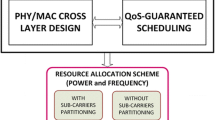Abstract
Multi-band Orthogonal Frequency Division multiplexing based Ultra Wide-band (MB-OFDM UWB) technology is one of the strong alternatives for high data rate wireless personal area networks (WPANs) with low power consumption. The capacity of such systems is degraded by multi-path fading, shadowing, multi-user interference and noise. To improve system capacity under these adverse effects, in this paper, we devise cross-layer time scheduling methods, Proportional Time Scheduling with Modiano Algorithm (PTS-MA) and Proportional Time Scheduling with Channel State Information (PTS-CSI), in which scheduling and link adaptation are performed using instantaneous bit error probability (IBEP) estimates obtained through Modiano’s algorithm and our novel estimation technique, respectively. We evaluate the performance of the PTS schemes by using numerical experiments. Simulation results suggest PTS-CSI scheduler as the most promising candidate for practical MB-OFDM UWB WPANs with high capacity and fair throughput distribution.







Similar content being viewed by others
Notes
Here, we assume that Imm-Ack packets are transmitted without errors, since such small control packets can be well protected by strong error correction.
References
Di Benedetto, M. G., & Giancola, G. (2004). Understanding ultra wide band radio fundamentals. Upper Saddle River, NJ: Prentice Hall.
Federal Communications Commission. (2002). First report and order 02-48.
Digital T.V., & Tutorial H.D.T.V. http://www.timefordvd.com/tutorial/DigitalTVTutorial.shtml.
Walrand, J., & Varaiya, P. (2000). High-performance communication networks (2nd ed.). San Francisco: Morgan Kaufmann.
Cass, S. (2005). Viva mesh vegas. IEEE Spectrum, 42(1), 48–53.
Akyildiz, I. F., Wang, X., & Wang, W. (2005). Wireless mesh networks: A survey. Elsevier Computer Networks, 47(4), 445–487.
Fisher, R., Kohno, R., Mc Laughlin, M., Welborn, M. (2004). DS-UWB physical layer submission. Document IEEE 802.15-03.
Batra, A., et al. (2003). Multi-band OFDM physical layer proposal. Document IEEE 802.15-03.
Batra, A., Balakrishnan, J., Aiello, G. R., Foerster, J. R., & Dabak, A. (2004). Design of a multiband OFDM system for realistic UWB channel environments. IEEE Transactions on Microwave Theory and Techniques, 52(9), 2123–2138. doi:10.1109/TMTT.2004.834184.
IEEE Std 802.15.3. (2003). IEEE standard for information technology—telecommunications and information exchange between systems—local and metropolitan area networks—specific requirements part 15.3: Wireless medium access control (MAC) and physical layer (PHY) specifications for high rate wireless personal area networks (WPANs).
Liu, X., Chong, E. K. P., & Shroff, N. B. (2001). Opportunistic transmission scheduling with resource-sharing constraints in wireless networks. IEEE Journal on Selected Areas in Communications, 19(10), 2053–2064. doi:10.1109/49.957318.
Jalali, A., Padovani, R., & Pankaj, R. (2000). Data throughput of CDMA-HDR: A high efficiency-high data rate personal communication wireless system. Proceedings of IEEE Vehicular Technology Conference Spring ‘00, (pp. 1854–1858). Tokyo, Japan.
Zhang, Z., He, Y., & Chong, E. K. P. (2005). Opportunistic downlink scheduling for multiuser OFDM systems. IEEE Wireless Communications and Networking Conference, 2, 206–1212.
Modiano, E. (1999). An adaptive algorithm for optimizing the packet size used in wireless ARQ protocols. Wireless Networks, 5, 279–286. doi:10.1023/A:1019111430288.
Molisch, A. F., Foerster, J. R., & Pendergrass, M. (2003). Channel models for ultrawideband personal area networks. IEEE Wireless Communications, 10(6), 14–21. doi:10.1109/MWC.2003.1265848.
Foerster, J., et al. (2003). Channel modeling sub-committee report final, IEEE 802.15-02/490.
Leon-Garcia, A., & Widjaja, I. (2004). Communication networks: fundamental concepts and key architectures. New York, NY: McGraw-Hill.
Rangnekar, A., & Sivalingam, K. M. (2004). Multiple channel scheduling in UWB based IEEE 802.15.3 networks. First International Conference on Broadband Networks (pp. 406–415).
Ranran, Z., & Geng-Sheng, K. (2005). A novel scheduling scheme and MAC enhancements for IEEE 802.15.3 high-rate WPAN. IEEE Wireless Communications and Networking Conference, 4, 2478–2483.
Wessman, M.-O., & Svensson, A., Agrell, F. (2004). Frequency diversity performance of coded multiband-OFDM systems on IEEE UWB Channels, IEEE Vehicular Technology Conference (pp. 1197–1201).
Goldsmith, A. (2005). Wireless communications (1st ed.). New York, NY: Cambridge University Press.
Golub, G., & Van Loan, C. F. (1996). Matrix computations (3rd ed.). Baltimore, MD: The Johns Hopkins University Press.
Acknowledgments
This work is supported by the Scientific and Technological Research Council of Turkey (TUBITAK) under grant No. 105E082.
Author information
Authors and Affiliations
Corresponding author
Rights and permissions
About this article
Cite this article
Keskinoz, M., Gurbuz, O. & Masazade, E. Cross-layer enhanced time scheduling for multi-band OFDM UWB networks. Wireless Netw 16, 863–873 (2010). https://doi.org/10.1007/s11276-009-0173-2
Published:
Issue Date:
DOI: https://doi.org/10.1007/s11276-009-0173-2




